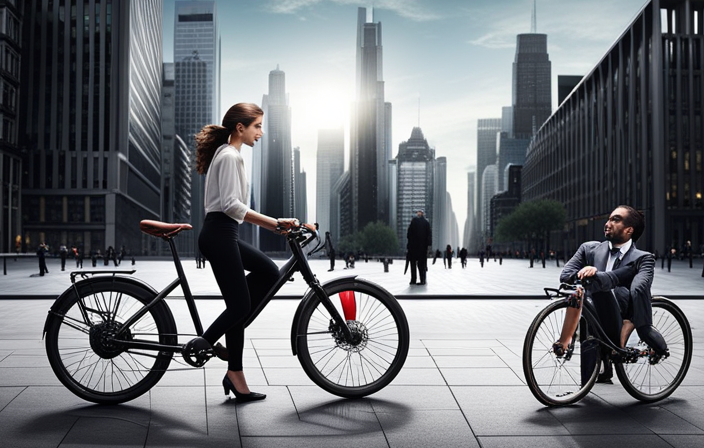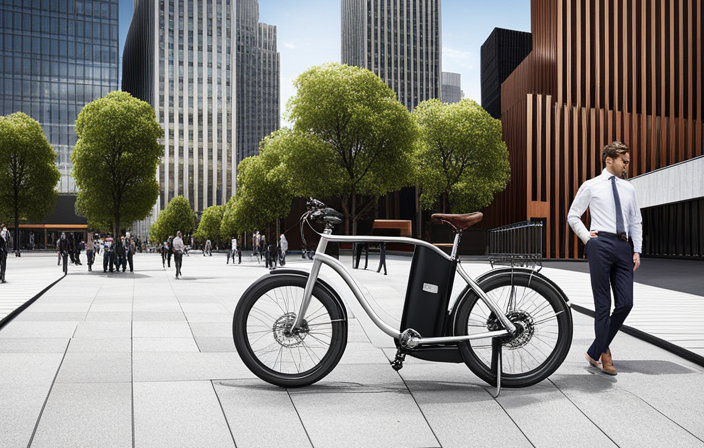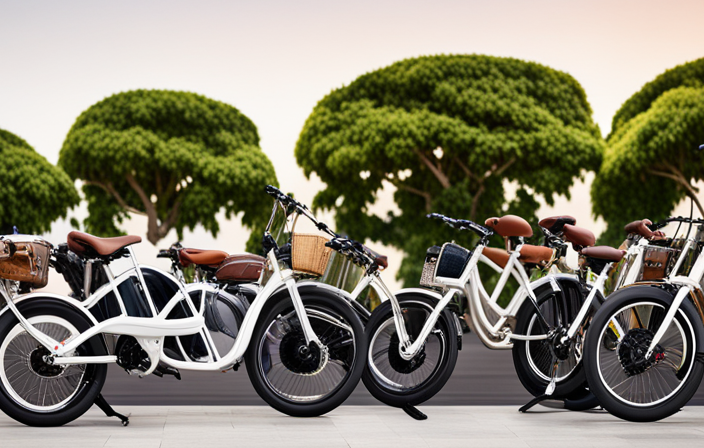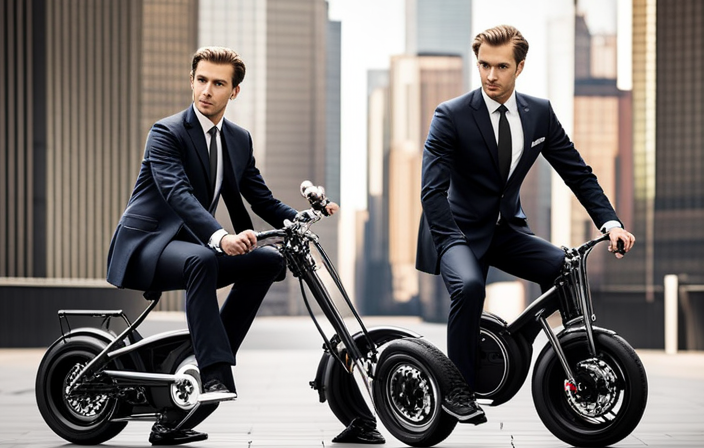I’ve always loved biking, but I wanted to take it to the next level. So, I started researching how to make my bike completely electric.
After diving into the world of electric motors and batteries, I realized that with the right tools and materials, it’s actually quite doable.
In this article, I’ll guide you through the step-by-step process of converting your bike into a fully electric ride.
Get ready to transform your cycling experience and enjoy the thrill of a powerful electric bike!
Key Takeaways
- Troubleshoot common electrical issues before making any modifications
- Choose between an electric throttle or pedal assist system based on personal preference and riding style
- Test the electric system thoroughly to ensure all components are functioning properly
- Adjust brakes and gears to optimize performance and ensure seamless integration of the electric system
Assess your bike’s compatibility for conversion
Before you start, make sure your bike’s frame and components are suitable for conversion. Evaluating compatibility is crucial to ensure a successful electric bike conversion.
Firstly, assess the frame material and design. Aluminum or steel frames are typically the best options for converting to electric.
Next, consider the space available for the battery and motor. Measure the dimensions of your frame and ensure there is enough room to accommodate these components.
Additionally, evaluate the condition of your bike’s components. Upgrading to high-quality brakes, gears, and suspension can enhance the overall performance and safety of your electric bike.
If necessary, modify the frame by adding mounting brackets or reinforcements to securely attach the motor and battery.
Choose the right motor and battery for your needs
When choosing the right motor and battery for your needs, it’s important to consider factors such as power output and battery capacity. These elements will determine the optimal performance of your electric bike.
Here are some key considerations to keep in mind:
- Power output: Look for a motor that provides sufficient power to match your desired speed and terrain requirements.
- Battery capacity: Choose a battery with a capacity that aligns with your desired range. Advanced battery technology can enhance your bike’s range and power.
- Voltage and current: Ensure that the motor and battery are compatible in terms of voltage and current requirements.
- Weight and size: Consider the weight and size of the motor and battery to ensure they fit well within your bike’s frame.
Gather the necessary tools and materials
To gather the necessary tools and materials for the conversion process, you’ll need to make a list of items required for the job.
When it comes to choosing the right battery for your electric bike, there are a few factors to consider. First, determine the voltage and capacity you need based on the distance you plan to travel and the power requirements of your motor.
Next, consider the size and weight of the battery, as it will affect the overall performance and handling of your bike.
Once you’ve selected the battery, it’s important to securely mount it onto the bike. Use sturdy brackets or mounts to ensure the battery stays in place, even during rough rides.
Now that you have the battery ready, it’s time to move on to the next step: removing the bike’s existing components, such as the chain and pedals.
Remove the bike’s existing components, such as the chain and pedals
Once you’ve gathered the necessary tools and materials, it’s time to remove the bike’s existing components, such as the chain and pedals. This step is crucial in the bike modification process as it prepares the frame for the electric conversion.
Start by using a chain breaker tool to remove the bike chain. Simply align the tool with one of the chain links and turn the handle until the pin is pushed out.
Next, use a pedal wrench to loosen and remove the pedals. Turn the wrench counterclockwise to loosen the pedals and then remove them from the crank arms.
Install the electric motor onto the bike frame
Now that you have the necessary tools and materials, it’s time to attach the electric motor onto the frame. Here’s what you need to do:
-
Choosing the right electric motor for your bike:
- Consider the power and torque requirements based on your riding preferences and terrain.
- Ensure compatibility with your bike’s frame and drivetrain.
- Look for a motor that is lightweight and efficient to maximize performance and battery life.
-
Securing the motor and battery onto the bike frame:
- Position the motor on the frame in a way that ensures proper alignment with the drivetrain.
- Use mounting brackets or clamps to securely attach the motor to the frame.
- Place the battery in a designated holder or secure it with straps to prevent any movement during rides.
Connect the motor to the bike’s drivetrain
First, you’ll need to ensure the motor is aligned properly with the bike’s drivetrain. This step is crucial for a smooth and efficient bike motor installation. Before connecting the motor, it’s important to assess its compatibility with your bike. Check the motor’s specifications and compare them with your bike’s drivetrain system to ensure a proper fit. To help you understand the compatibility assessment better, take a look at the table below:
| Motor Specification | Bike Drivetrain Specification | Compatibility |
|---|---|---|
| Voltage | Gearing | ✓ |
| Power | Chainring Size | ✓ |
| Torque | Cassette Teeth | ✓ |
| Weight | Bottom Bracket Type | ✓ |
| Size | Chain Length | ✓ |
Mount the battery securely onto the bike
To securely mount the battery onto your bike, ensure that you have the necessary mounting brackets and tools. Start by finding a suitable location on your bike frame where the battery can be securely attached. Make sure it is easily accessible for maintenance and charging.
Once you have identified the spot, use the mounting brackets to secure the battery in place. Double-check that all the connections are tight and that there is no risk of the battery coming loose during rides.
It is also important to take care of the wiring connections to ensure a reliable and safe electrical connection. Regularly inspect the wires for any signs of damage or wear, and address any issues promptly.
When it comes to battery maintenance, make sure to follow the manufacturer’s guidelines for charging and storage. Proper charging techniques can help prolong the battery’s lifespan and ensure optimal performance.
Now that the battery is securely mounted, let’s move on to connecting it to the motor and other electrical components.
Connect the battery to the motor and other electrical components
Once you’ve securely mounted the battery, it’s time to connect it to the motor and other electrical components.
The first step is to locate the motor controller, which is responsible for regulating the power flow between the battery and the motor. Connect the positive and negative wires from the battery to the corresponding terminals on the motor controller. Ensure that the connections are tight and secure.
Next, connect the motor wires to the motor controller, following the manufacturer’s instructions. It’s important to double-check all connections and ensure they are properly insulated to prevent any short circuits.
Troubleshooting common electrical issues in electric bikes can involve checking for loose connections, damaged wires, or blown fuses.
Now that the battery is connected, let’s move on to installing an electric throttle or pedal assist sensor, which will allow you to control the motor’s power output.
Install an electric throttle or pedal assist sensor
Now that you’ve connected the battery, it’s time to install an electric throttle or pedal assist sensor.
The choice between an electric throttle and pedal assist depends on your preference and riding style.
An electric throttle allows you to control the speed of your electric bike with a twist of your wrist, similar to a motorcycle.
On the other hand, a pedal assist sensor detects your pedaling motion and provides assistance based on the level you have set.
Both options have their benefits.
With an electric throttle, you have instant control over your speed, while pedal assist offers a more intuitive and natural riding experience.
Converting a bike to electric has numerous benefits, including increased speed, extended range, and reduced effort while riding.
Now, let’s move on to testing the electric system to ensure everything is functioning properly.
Test the electric system to ensure everything is functioning properly
First, you’ll want to check that all the connections are secure and there are no loose wires. This is an essential step in testing the electric system of your bike.
To begin, ensure that the battery is properly connected and charged. Then, turn on the power and check if the display or control panel lights up. If it does, proceed to test the throttle or pedal assist sensor. Give it a gentle twist or pedal and observe if the motor engages smoothly.
If there are any issues, such as the motor not responding or strange noises, refer to the troubleshooting tips provided by the manufacturer. It’s crucial to address any problems before adjusting the bike’s brakes and gears to accommodate the electric system.
Adjust the bike’s brakes and gears to accommodate the electric system
To properly integrate the electric system, you’ll need to make adjustments to the brakes and gears on your bike. Modifying the brakes is essential to ensure that you have sufficient stopping power when riding your electric bike. Since an electric bike is generally heavier than a regular bike, it’s important to have brakes that can handle the increased weight and speed. You may need to replace your existing brake pads with ones that are specifically designed for electric bikes.
Additionally, adjusting the gears is necessary to optimize the performance of your electric bike. The added power from the electric motor may require different gear ratios to maintain a smooth and efficient ride. By modifying the brakes and adjusting the gears, you can ensure that your electric bike functions seamlessly.
Now, let’s move on to installing additional accessories, such as lights or a display panel.
Install additional accessories, such as lights or a display panel
When installing additional accessories, such as lights or a display panel, you’ll want to ensure that they are compatible with your electric bike’s system.
Adding lights and a display panel to your electric bike can bring several benefits. Lights increase visibility and safety, especially when riding in low-light conditions. They also make it easier for other road users to see you.
A display panel provides valuable information about your electric bike’s battery level, speed, and distance traveled. It helps you monitor your ride and make informed decisions.
When choosing the right accessories for your electric bike conversion, consider factors such as compatibility, durability, and ease of installation.
Now that you have added lights and a display panel, consider adding regenerative braking for increased efficiency.
Consider adding regenerative braking for increased efficiency
Consider adding regenerative braking to increase your electric bike’s efficiency and improve its overall performance. Regenerative braking is a technology that converts the kinetic energy generated during braking into electrical energy, which is then stored in the battery for later use. This innovative feature offers several benefits, including:
-
Enhanced Range: By harnessing the energy that would otherwise be wasted during braking, regenerative braking can extend the distance you can travel on a single charge.
-
Increased Battery Life: The ability to recharge the battery through regenerative braking helps reduce the strain on the battery, leading to a longer lifespan.
-
Smoother Ride: Regenerative braking provides a more controlled and responsive braking experience, enhancing safety and rider comfort.
Implementing regenerative braking on a bike, however, does come with its challenges. The main obstacle is the additional weight and complexity it adds to the bike, requiring careful integration and compatibility with the existing components.
Nonetheless, the benefits make it a worthwhile consideration. Once you have installed regenerative braking, take your bike for a test ride and make any necessary adjustments to ensure optimal performance.
Take your bike for a test ride and make any necessary adjustments
After considering the addition of regenerative braking for increased efficiency, it’s time to take your newly electrified bike for a test ride.
A test ride is crucial to ensure that everything is working as expected and to experience the benefits of your transformed electric bike.
During the test ride, pay attention to the acceleration, braking, and overall handling of the bike. This will give you an idea of how well the electric components integrate with your existing bike.
Additionally, it’s important to make any necessary adjustments during this ride. Check the seat height and position, handlebar alignment, and tire pressure to optimize your comfort and control. Taking the time to adjust these elements will greatly enhance your riding experience.
Once you’re satisfied, you can confidently enjoy your newly transformed electric bike!
Enjoy your newly transformed electric bike!
You can now fully appreciate the benefits of your newly transformed e-bike! By installing a bike conversion kit, you have turned your ordinary bike into an electric powerhouse.
Converting a bike to electric offers numerous advantages. First and foremost, it provides you with an effortless and enjoyable ride. The electric motor helps you conquer hills and overcome long distances with ease.
Additionally, converting your bike allows you to travel at higher speeds, making your commute faster and more efficient. Another benefit is the environmental impact. Electric bikes produce zero emissions, reducing your carbon footprint and contributing to a cleaner, greener environment.
Lastly, converting your bike to electric is cost-effective. You save money on fuel and maintenance, as well as on transportation expenses.
Enjoy the freedom and convenience of your newly transformed electric bike!
Frequently Asked Questions
Can I convert any type of bike into an electric bike?
Yes, any type of bike can be converted into an electric bike using electric bike conversion kits. Converting a bike to electric offers numerous benefits, such as increased speed, longer range, and a more eco-friendly mode of transportation.
How do I choose the right motor and battery for my specific needs?
Choosing the right motor and battery for an electric bike conversion can be challenging. However, by considering factors such as power output, voltage, and capacity, you can find the perfect combination for your specific needs. Electric bike battery and motor selection requires careful research and consideration.
What tools and materials do I need to gather before starting the conversion process?
To convert a bike into an electric vehicle, gather tools like wrenches, pliers, and screwdrivers. Materials needed include an electric motor, a battery, a controller, wiring, and a throttle. Choose a motor suitable for your bike’s power requirements. It is possible to convert a scooter into an electric vehicle.
How do I connect the battery to the motor and other electrical components?
To connect the battery to the motor and other electrical components, refer to a wiring diagram for electric bikes. It provides a visual guide on how to properly connect the wires, ensuring a smooth and efficient operation.
Should I consider adding regenerative braking to my electric bike for increased efficiency?
Regenerative braking in electric bikes has pros and cons. It recovers energy during braking, increasing efficiency. However, the added weight of the system can reduce overall range. It works by converting kinetic energy into electrical energy, which is stored in the battery.
Conclusion
After months of research and hard work, I finally completed the transformation of my bike into an electric powerhouse.
As I cruised through the streets, feeling the surge of power from the motor, I couldn’t help but be reminded of the immense potential within each of us.
Just like my bike, we all have the ability to adapt, grow, and overcome obstacles. With determination and the right tools, we can transform ourselves into something truly extraordinary.
So go out there and embrace your own electric journey!









